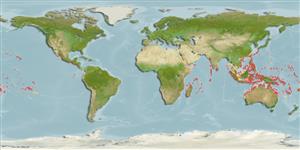Classification / Names
Common names from other countries
Main reference
Size / Weight / Age
Max length : 11.5 cm TL male/unsexed; (Ref. 90102)
Environment
Marine; reef-associated; depth range 0 - 15 m (Ref. 93839)
Climate / Range
Tropical, preferred ?; 30°N - 30°S
Distribution
Indo-Pacific: Red Sea and Sodwana Bay, South Africa (Ref. 4329) to the Line and Pitcairn islands, north to southern Japan, south to New South Wales (Australia) and Rapa.
Countries | FAO areas | Ecosystems | Occurrences | Introductions
Short description
Dorsal
spines
(total): 8;
Dorsal
soft rays
(total): 9;
Anal
spines: 2;
Anal
soft rays: 8. Characterized by having dorsal fin rays VII-I, 9; anal fin rays II,8; pectoral fin rays 14; pelvic fin rays I, 5; pored lateral line scales 24; predorsal scales 3-4; circumpeduncular scales 12 (Ref. 93839); Whitish with 5-6 black stripes (Ref. 2334). Secondary dark line extends backwards as far as the first dorsal fin, in large specimens (Ref. 37816). Absence of dark spot on caudal fin base; greatest depth of body 2.7-3.0 in SL (Ref.90102).
IUCN Red List Status (Ref. 115185)
Threat to humans
Harmless
Human uses
Aquarium: commercial
More information
ReferencesAquacultureAquaculture profileStrainsGeneticsAllele frequenciesHeritabilityDiseasesProcessingMass conversion
Tools
Special reports
Download XML
Internet sources
Estimates of some properties based on models
Phylogenetic diversity index
PD50 = 0.5000 many relatives (e.g. carps) 0.5 - 2.0 few relatives (e.g. lungfishes)
Trophic Level
3.5 ±0.5 se; Based on size and trophs of closest relatives
Resilience
High, minimum population doubling time less than 15 months (Preliminary K or Fecundity.)
Vulnerability
Low vulnerability (13 of 100)
Price category
